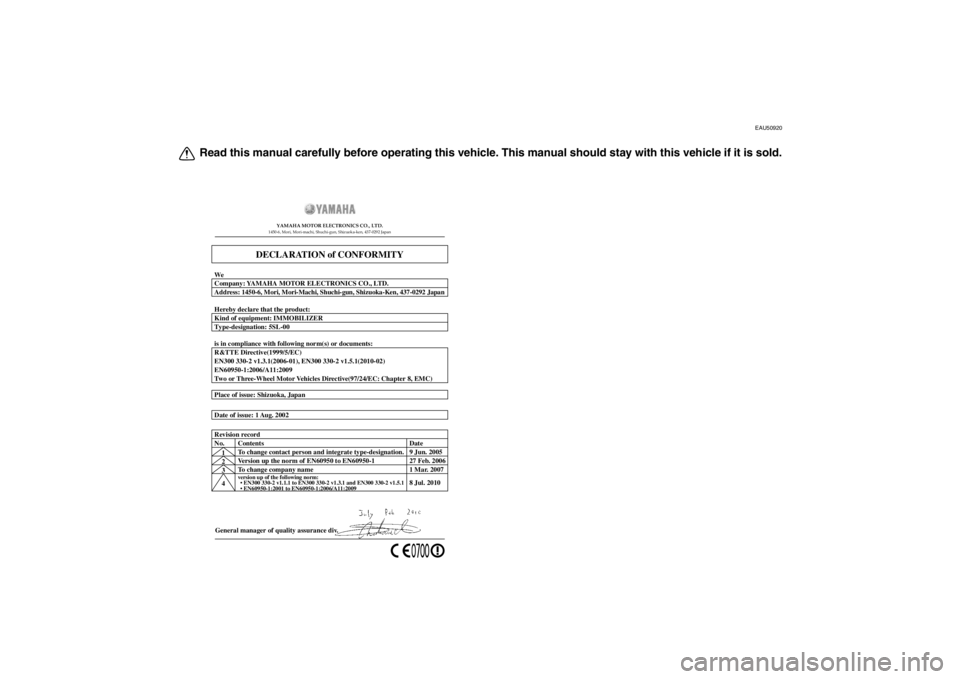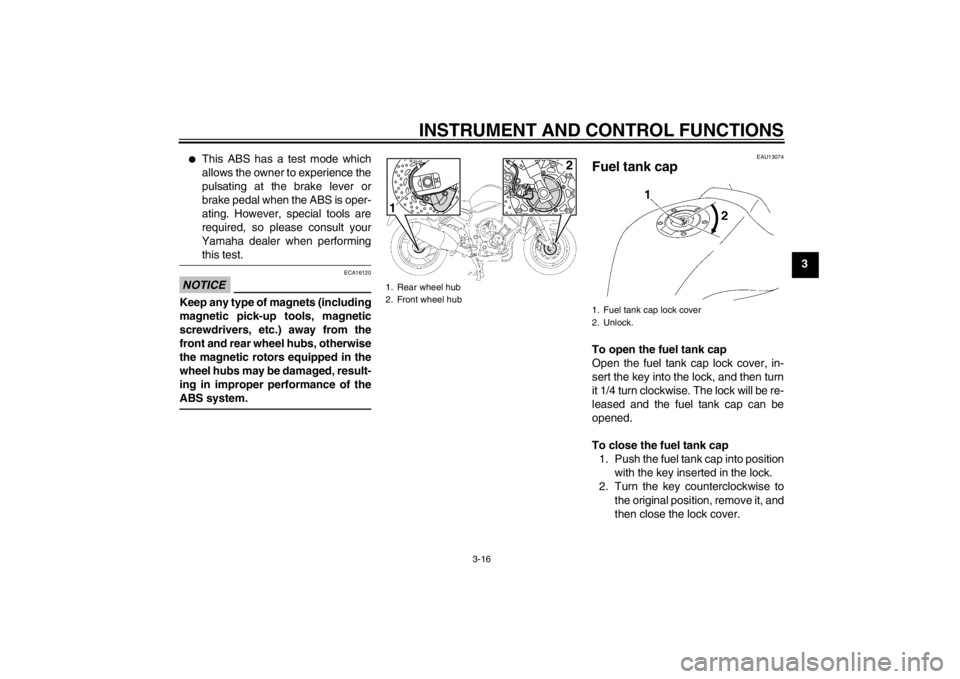2012 YAMAHA FZ1 S wheel
[x] Cancel search: wheelPage 2 of 106

EAU50920
Read this manual carefully before operating this vehicle. This manual should stay with this vehicle if it is sold.
General manager of quality assurance div.
Date of issue: 1 Aug. 2002 Place of issue: Shizuoka, Japan
DECLARATION of CONFORMITY
YAMAHA MOTOR ELECTRONICS CO., LTD.1450-6, Mori, Mori-machi, Shuchi-gun, Shizuoka-ken, 437-0292 Japan
Company: YAMAHA MOTOR ELECTRONICS CO., LTD. We
Address: 1450-6, Mori, Mori-Machi, Shuchi-gun, Shizuoka-Ken, 437-0292 Japan
Kind of equipment: IMMOBILIZER Hereby declare that the product:
Type-designation: 5SL-00
is in compliance with following norm(s) or documents:
R&TTE Directive(1999/5/EC)
EN300 330-2 v1.3.1(2006-01), EN300 330-2 v1.5.1(2010-02)
EN60950-1:2006/A11:2009
Two or Three-Wheel Motor Vehicles Directive(97/24/EC: Chapter 8, EMC)
1
2
3
4 Version up the norm of EN60950 to EN60950-1
To change company name
version up of the following norm:
• EN300 330-2 v1.1.1 to EN300 330-2 v1.3.1 and EN300 330-2 v1.5.1
27 Feb. 2006
1 Mar. 2007
8 Jul. 2010
Revision record
No. Contents
To change contact person and integrate type-designation. Date
9 Jun. 2005
U1CAE1E0.book Page 1 Tuesday, September 13, 2011 5:02 PM
Page 6 of 106

TABLE OF CONTENTSSAFETY INFORMATION ..................1-1
DESCRIPTION ..................................2-1
Left view ..........................................2-1
Right view ........................................2-2
Controls and instruments.................2-3
INSTRUMENT AND CONTROL
FUNCTIONS .......................................3-1
Immobilizer system .........................3-1
Main switch/steering lock ................3-2
Indicator lights and warning lights ..............................3-4
Multi-function meter unit .................3-8
Anti-theft alarm (optional) .............3-12
Handlebar switches ......................3-13
Clutch lever ...................................3-14
Shift pedal .....................................3-14
Brake lever ...................................3-15
Brake pedal ..................................3-15
ABS (for ABS models) ..................3-15
Fuel tank cap ................................3-16
Fuel ...............................................3-17
Fuel tank breather hose and
overflow hose ............................3-18
Catalytic converters ......................3-19
Seats ............................................3-19
Storage compartment ...................3-21
Rear view mirrors .........................3-21
Adjusting the front fork ..................3-22 Adjusting the shock absorber
assembly ................................... 3-24
Luggage strap holders ................. 3-25
EXUP system ............................... 3-26
Sidestand ..................................... 3-26
Ignition circuit cut-off system ........ 3-27
FOR YOUR SAFETY –
PRE-OPERATION CHECKS ............. 4-1
OPERATION AND IMPORTANT
RIDING POINTS ................................. 5-1
Starting the engine ......................... 5-1
Shifting ........................................... 5-2
Tips for reducing fuel consumption ............................... 5-3
Engine break-in .............................. 5-3
Parking ........................................... 5-4
PERIODIC MAINTENANCE AND
ADJUSTMENT ................................... 6-1
Owner’s tool kit ............................... 6-2
Periodic maintenance chart for the emission control system ....... 6-3
General maintenance and lubrication chart .......................... 6-4
Removing and installing panels ..... 6-8
Checking the spark plugs ............... 6-9
Engine oil and oil filter cartridge ... 6-10
Coolant ......................................... 6-13
Replacing the air filter element ..... 6-14 Adjusting the engine idling
speed ........................................ 6-17
Checking the throttle grip free play ........................................... 6-17
Valve clearance ........................... 6-18
Tires ............................................. 6-18
Cast wheels ................................. 6-20
Adjusting the clutch lever free
play ........................................... 6-21
Checking the brake lever free play ........................................... 6-21
Brake light switches (for ABS models) ...................... 6-22
Brake light switches
(for non-ABS models) ............... 6-22
Checking the front and rear brake pads ........................ 6-23
Checking the brake fluid level ...... 6-23
Changing the brake fluid .............. 6-25
Drive chain slack .......................... 6-25
Cleaning and lubricating the drive chain .......................... 6-26
Checking and lubricating
the cables ................................. 6-27
Checking and lubricating the throttle grip and cable ......... 6-27
Checking and lubricating the brake and shift pedals ........ 6-28
Checking and lubricating
the brake and clutch levers ...... 6-28U1CAE1E0.book Page 1 Tuesday, September 13, 2011 5:02 PM
Page 7 of 106

TABLE OF CONTENTS
Checking and lubricating the centerstand and sidestand ........ 6-29
Checking the front fork ................. 6-30
Checking the steering ................... 6-30
Checking the wheel bearings ....... 6-31
Battery .......................................... 6-31
Replacing the fuses ...................... 6-32
Replacing a headlight bulb ........... 6-35
Replacing the tail/brake light bulb ........................................... 6-36
Replacing a turn signal light
bulb ........................................... 6-36
Replacing the license plate light bulb ........................................... 6-36
Replacing an auxiliary light bulb ... 6-37
Front wheel (for non-ABS models) ............... 6-38
Rear wheel (for non-ABS models) ............... 6-39
Troubleshooting ............................ 6-41
Troubleshooting charts ................. 6-42
MOTORCYCLE CARE AND
STORAGE .......................................... 7-1
Matte color caution ......................... 7-1
Care ................................................ 7-1
Storage ...........................................7-3 SPECIFICATIONS
............................ 8-1
CONSUMER INFORMATION ............ 9-1
Identification numbers .................... 9-1
U1CAE1E0.book Page 2 Tuesday, September 13, 2011 5:02 PM
Page 9 of 106

SAFETY INFORMATION
1-2
1
due to excessive speed or under-
cornering (insufficient lean angle
for the speed).
Always obey the speed limit and never travel faster than warrant-
ed by road and traffic conditions.
Always signal before turning or changing lanes. Make sure that
other motorists can see you.
●
The posture of the operator and
passenger is important for proper
control. The operator should keep both hands on the handlebar and
both feet on the operator foot-
rests during operation to main-
tain control of the motorcycle.
The passenger should always hold onto the operator, the seat
strap or grab bar, if equipped,
with both hands and keep both
feet on the passenger footrests.
Never carry a passenger unless
he or she can firmly place both
feet on the passenger footrests.
●
Never ride under the influence of
alcohol or other drugs.
●
This motorcycle is designed for on-
road use only. It is not suitable for
off-road use.
Protective Apparel
The majority of fatalities from motorcy-
cle accidents are the result of head in-
juries. The use of a safety helmet is the
single most critical factor in the preven-
tion or reduction of head injuries.
●
Always wear an approved helmet.
●
Wear a face shield or goggles.
Wind in your unprotected eyes
could contribute to an impairment
of vision that could delay seeing a
hazard.
●
The use of a jacket, heavy boots,
trousers, gloves, etc., is effective in
preventing or reducing abrasions
or lacerations.
●
Never wear loose-fitting clothes,
otherwise they could catch on the
control levers, footrests, or wheels
and cause injury or an accident.
●
Always wear protective clothing
that covers your legs, ankles, and
feet. The engine or exhaust sys-
tem become very hot during or af-
ter operation and can cause burns.
●
A passenger should also observe
the above precautions.
Avoid Carbon Monoxide Poisoning
All engine exhaust contains carbon
monoxide, a deadly gas. Breathing car-
bon monoxide can cause headaches,
dizziness, drowsiness, nausea, confu-
sion, and eventually death.
Carbon Monoxide is a colorless, odor-
less, tasteless gas which may be
present even if you do not see or smell
any engine exhaust. Deadly levels of
carbon monoxide can collect rapidly
and you can quickly be overcome and
unable to save yourself. Also, deadly
levels of carbon monoxide can linger
for hours or days in enclosed or poorly
ventilated areas. If you experience any
symptoms of carbon monoxide poison-
ing, leave the area immediately, get
fresh air, and SEEK MEDICAL TREAT-
MENT.
●
Do not run engine indoors. Even if
you try to ventilate engine exhaust
with fans or open windows and
doors, carbon monoxide can rap-
idly reach dangerous levels.
U1CAE1E0.book Page 2 Tuesday, September 13, 2011 5:02 PM
Page 12 of 106

SAFETY INFORMATION
1-5
1
●
Check that the fuel cock (if
equipped) is in the “OFF” position
and that there are no fuel leaks.
●
Point the front wheel straight
ahead on the trailer or in the truck
bed, and choke it in a rail to pre-
vent movement.
●
Shift the transmission in gear (for
models with a manual transmis-
sion).
●
Secure the motorcycle with tie-
downs or suitable straps that are
attached to solid parts of the mo-
torcycle, such as the frame or up-
per front fork triple clamp (and not,
for example, to rubber-mounted
handlebars or turn signals, or parts
that could break). Choose the lo-
cation for the straps carefully so
the straps will not rub against
painted surfaces during transport.
●
The suspension should be com-
pressed somewhat by the tie-
downs, if possible, so that the mo-
torcycle will not bounce excessive-
ly during transport.
U1CAE1E0.book Page 5 Tuesday, September 13, 2011 5:02 PM
Page 22 of 106

INSTRUMENT AND CONTROL FUNCTIONS
3-7
3
EAU11534
Engine trouble warning light “ ”
This warning light comes on or flashes
if a problem is detected in the electrical
circuit monitoring the engine. If this oc-
curs, have a Yamaha dealer check the
self-diagnosis system. (See page 3-11
for an explanation of the self-diagnosis
device.)
The electrical circuit of the warning light
can be checked by turning the key to
“ON”. The warning light should come
on for a few seconds, and then go off.
If the warning light does not come on
initially when the key is turned to “ON”,
or if the warning light remains on, have
a Yamaha dealer check the electrical
circuit.
EAU11545
ABS warning light “ ” (for ABS
models)
If this warning light comes on or flashes
while riding, the ABS may not work cor-
rectly. If this occurs, have a Yamaha
dealer check the system as soon as
possible. (See page 3-15.)
WARNING
EWA10081
If the ABS warning light comes on or
flashes while riding, the brake sys-
tem reverts to conventional braking.
Therefore, be careful not to cause
the wheels to lock during emergen-
cy braking. If the warning light
comes on or flashes while riding,
have a Yamaha dealer check the
brake system as soon as possible.The electrical circuit of the warning light
can be checked by turning the key to
“ON”. The warning light should come
on for a few seconds, and then go off.
If the warning light does not come on
initially when the key is turned to “ON”,
or if the warning light remains on, have
a Yamaha dealer check the electrical
circuit.
EAU38624
Immobilizer system indicator light
The electrical circuit of the indicator
light can be checked by turning the key
to “ON”. The indicator light should
come on for a few seconds, and then
go off.If the indicator light does not come on
initially when the key is turned to “ON”,
or if the indicator light remains on, have
a Yamaha dealer check the electrical
circuit.
When the key is turned to “OFF” and 30
seconds have passed, the indicator
light will start flashing indicating the im-
mobilizer system is enabled. After 24
hours have passed, the indicator light
will stop flashing, however the immobi-
lizer system is still enabled.
The self-diagnosis device also detects
problems in the immobilizer system cir-
cuits. (See page 3-11 for an explana-
tion of the self-diagnosis device.)
ABS
U1CAE1E0.book Page 7 Tuesday, September 13, 2011 5:02 PM
Page 31 of 106

INSTRUMENT AND CONTROL FUNCTIONS
3-16
3
●
This ABS has a test mode which
allows the owner to experience the
pulsating at the brake lever or
brake pedal when the ABS is oper-
ating. However, special tools are
required, so please consult your
Yamaha dealer when performing this test.
NOTICE
ECA16120
Keep any type of magnets (including
magnetic pick-up tools, magnetic
screwdrivers, etc.) away from the
front and rear wheel hubs, otherwise
the magnetic rotors equipped in the
wheel hubs may be damaged, result-
ing in improper performance of the
ABS system.
EAU13074
Fuel tank cap To open the fuel tank cap
Open the fuel tank cap lock cover, in-
sert the key into the lock, and then turn
it 1/4 turn clockwise. The lock will be re-
leased and the fuel tank cap can be
opened.
To close the fuel tank cap 1. Push the fuel tank cap into position with the key inserted in the lock.
2. Turn the key counterclockwise to the original position, remove it, and
then close the lock cover.
1. Rear wheel hub
2. Front wheel hub
2
1
1. Fuel tank cap lock cover
2. Unlock.
U1CAE1E0.book Page 16 Tuesday, September 13, 2011 5:02 PM
Page 45 of 106

FOR YOUR SAFETY – PRE-OPERATION CHECKS
4-2
4
Rear brake Check operation.
If soft or spongy, have Yamaha dealer bleed hydraulic system.
Check brake pads for wear.
Replace if necessary.
Check fluid level in reservoir.
If necessary, add specified brake fluid to specified level.
Check hydraulic system for leakage. 6-23, 6-23
Clutch Check operation.
Lubricate cable if necessary.
Check lever free play.
Adjust if necessary.
6-21
Throttle grip Make sure that operation is smooth.
Check throttle grip free play.
If necessary, have Yamaha dealer adjust throttle grip free play and lubricate cable
and grip housing. 6-17, 6-27
Control cables Make sure that operation is smooth.
Lubricate if necessary. 6-27
Drive chain Check chain slack.
Adjust if necessary.
Check chain condition.
Lubricate if necessary.
6-25, 6-26
Wheels and tires Check for damage.
Check tire condition and tread depth.
Check air pressure.
Correct if necessary.
6-18, 6-20
Brake and shift pedals Make sure that operation is smooth.
Lubricate pedal pivoting points if necessary. 6-28
Brake and clutch levers Make sure that operation is smooth.
Lubricate lever pivoting points if necessary.
6-28
Centerstand, sidestand Make sure that operation is smooth.
Lubricate pivots if necessary.
6-29
ITEM CHECKS PAGE
U1CAE1E0.book Page 2 Tuesday, September 13, 2011 5:02 PM